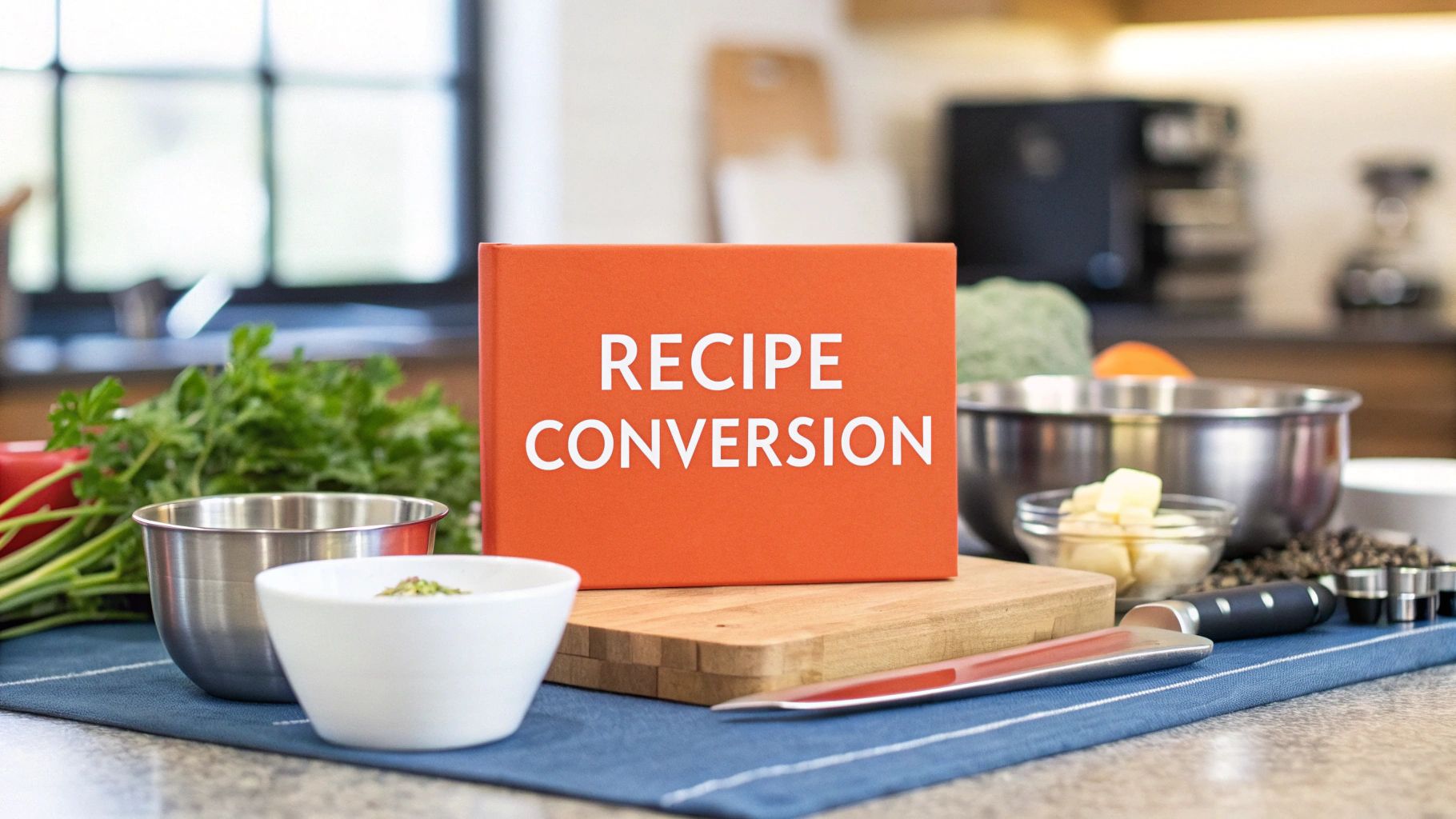The Fundamental Science of Recipe Conversion
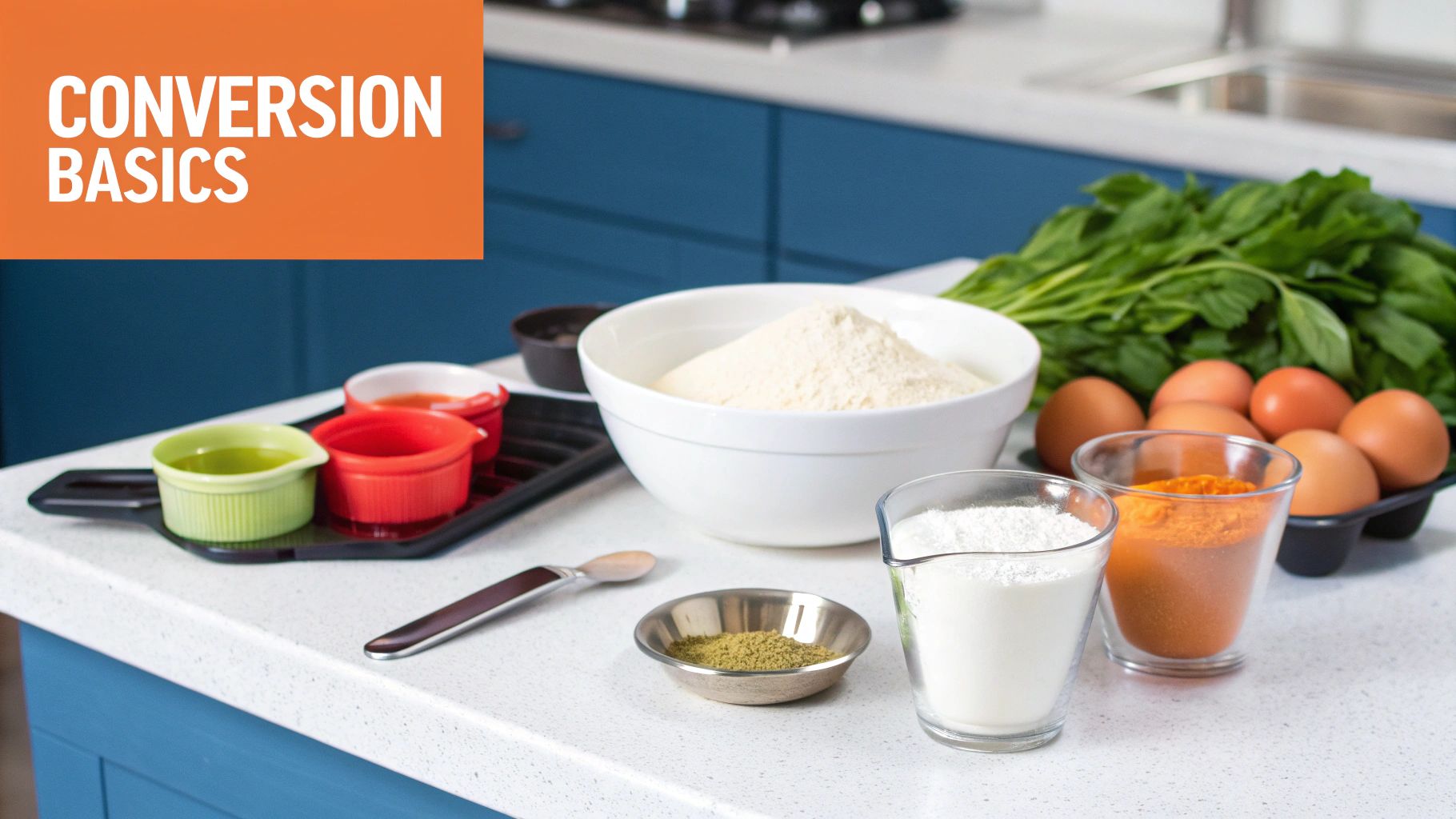
Converting a recipe isn't as simple as multiplying or dividing ingredients. It involves understanding the science behind how ingredients interact and how these interactions change when you adjust the recipe's scale. This careful approach is the difference between a delicious dish and a culinary disaster.
The Importance of Ratios
Maintaining the correct ratios of ingredients is essential when converting recipes. This ensures the desired flavor and texture remain consistent, no matter the serving size. Think of a recipe as a carefully balanced system. Altering that balance can have unexpected results. For instance, doubling the sugar in a cake could lead to a dense, overly sweet outcome.
Temperature also plays a vital role. Scaling a recipe often means adjusting cooking times and temperatures. A larger lasagna, for example, will need a longer baking time and possibly a lower oven temperature to avoid burning.
Understanding Ingredient Behavior
Some ingredients follow unique conversion rules, adding complexity to the process. Leavening agents like baking powder and yeast require precise adjustments when scaling, as their effectiveness changes based on the quantity of other ingredients.
Converting recipes is a key cooking skill, especially when changing serving sizes. While cooks traditionally relied on instinct, more accurate methods are used today. If a recipe serves 10 and you need 20 servings, multiply each ingredient by 2 (20/10 = 2). This maintains ingredient proportions, ensuring the flavor and texture are consistent. Modern tools further enhance precision. Explore this topic further/02:_Recipe_conversions_and_Braising/2.01:_Recipe_Conversion)
Read also: How to categorize recipes to manage your growing collection efficiently.
Overcoming Psychological Barriers
Even experienced cooks can hesitate when converting recipes. The fear of ruining a dish with small changes can lead to inaccurate conversions. A common mistake is focusing on individual ingredient amounts instead of the overall balance. Another is overlooking the different properties of ingredients.
However, simple frameworks exist to simplify recipe conversion and eliminate guesswork. Understanding the principles discussed here is the first step. With practice and helpful tools, such as those from Recify, you can confidently convert recipes and enjoy perfectly scaled dishes every time. The key is to approach conversion scientifically and be willing to experiment.
Scaling Recipes Without Sacrificing Flavor
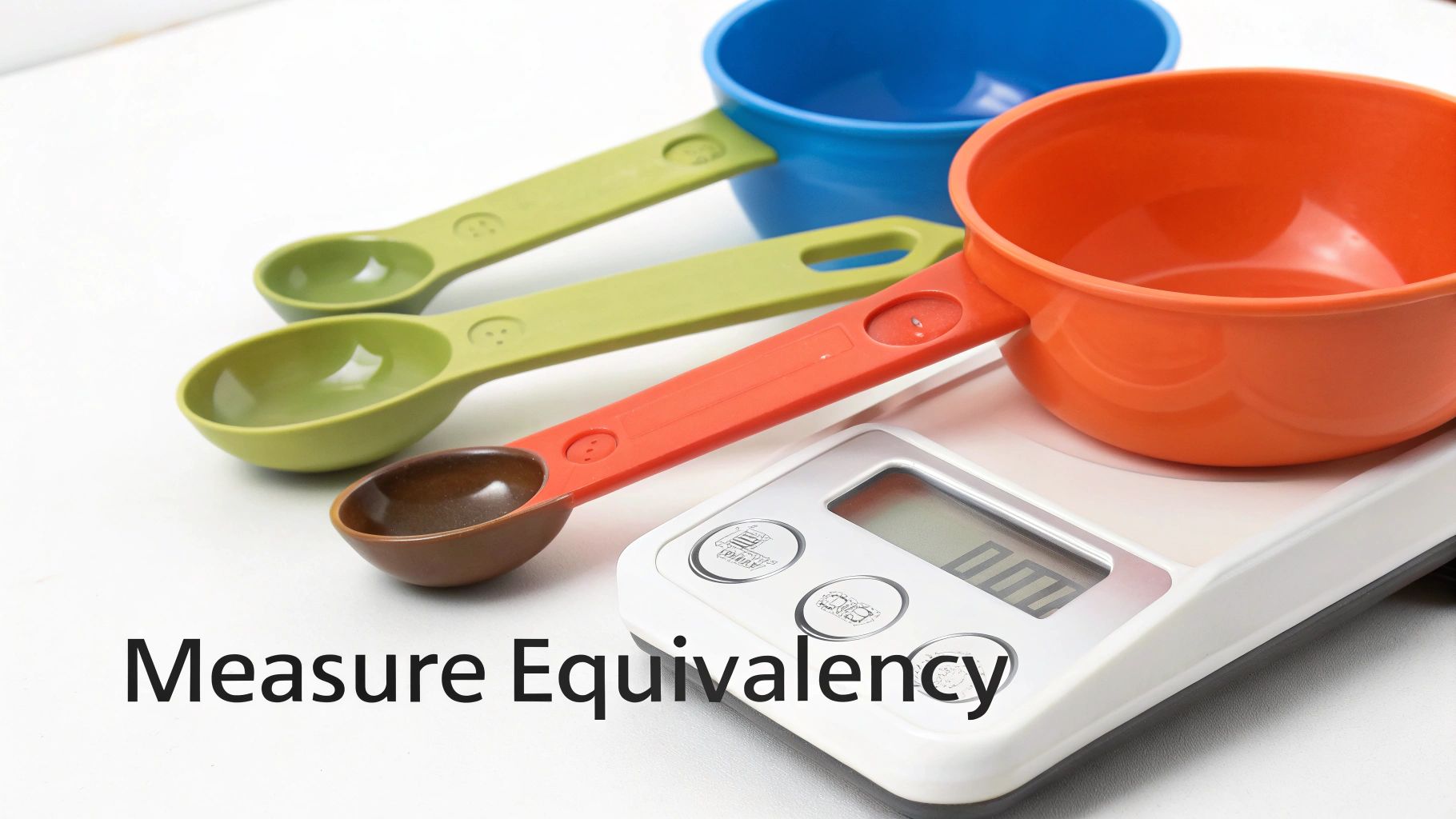
Scaling recipes, whether you're doubling for a crowd or halving for a cozy meal, can be tricky. Simply multiplying or dividing each ingredient doesn't always work. Certain ingredients, and how they interact, don't scale in a straightforward way. This section explores how to scale recipes effectively, so your dish tastes and feels just right.
Understanding the Math Behind Scaling
Scaling recipes starts with conversion factors. You find this factor by dividing the number of servings you want by the original number of servings in the recipe. To double a recipe, your conversion factor is 2 (desired servings / original servings = 2). But this factor isn't a one-size-fits-all solution.
Some ingredients, especially leavening agents like baking powder and yeast, need special care. Too much baking powder in a larger recipe can make things too airy and even create a metallic taste. Too little yeast can result in a dense, heavy finished product. So, the math of conversion factors needs tweaking based on the ingredient.
Adjusting Cooking Times and Temperatures
Scaling also affects cooking times and temperatures. A larger dish generally needs more time, while a smaller one needs less. A doubled casserole might need an extra 30 minutes.
Temperature is also key. A larger volume of food holds heat better, which can lead to burning on the outside while the inside stays undercooked. A smaller dish might cook too fast at a high temperature and dry out. Always check the internal temperature to make sure your dish is cooked through, no matter how you’ve scaled it.
Practical Examples and Troubleshooting
Imagine doubling a soup recipe. You might find that doubling the spices makes the flavor too strong. This is a common scaling problem. Instead, add spices a little at a time and taste as you go.
Baking is another example. Scaling up a cake recipe might mean changing the pan size and baking time. Using several smaller pans instead of one large one can ensure even baking. It's often a good idea to lower the oven temperature a bit and bake longer when working with larger amounts.
To help you scale recipes, here’s a simple table summarizing common conversions:
Recipe Scaling Conversion Factors
This table provides common conversion factors for scaling recipes up or down, showing how to accurately adjust ingredient quantities for different serving sizes.
| Original Servings | Desired Servings | Conversion Factor | Example (1 cup flour becomes) |
|---|---|---|---|
| 4 | 8 | 2 | 2 cups |
| 6 | 12 | 2 | 2 cups |
| 8 | 4 | 0.5 | 1/2 cup |
| 10 | 5 | 0.5 | 1/2 cup |
This table shows how to calculate the conversion factor and apply it to a simple ingredient like flour. Remember to consider the specific properties of ingredients like leavening agents when scaling your recipes. By understanding these principles and using the table as a guide, you can confidently scale recipes for any occasion.
Navigating Cross-Cultural Measurement Systems
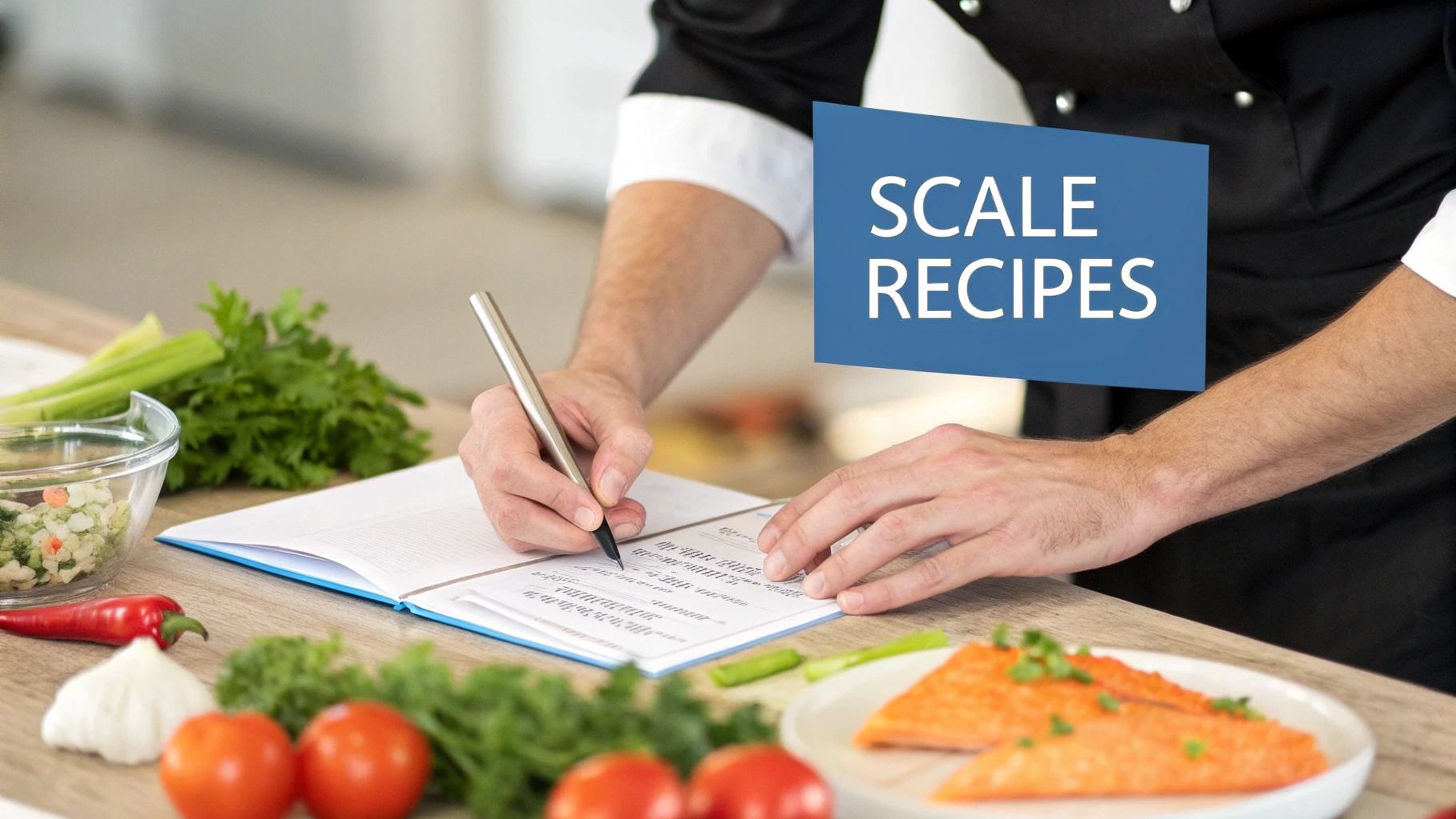
That perfect Italian pasta recipe you found online might list ingredients in grams, milliliters, and Celsius. If you're cooking in an American kitchen, you're probably more used to cups, ounces, and Fahrenheit. This difference highlights the challenge of converting recipes across measurement systems. This section will give you practical conversion techniques used by international chefs, so you can confidently tackle any recipe.
Precision Versus Flexibility in Conversions
Some recipe conversions need to be absolutely precise. Baking, for example, is a science. Small differences in measurements can significantly impact the final product. Other types of cooking are more flexible. A pinch more or less of a spice in a stew probably won't ruin the dish. Knowing this difference is key to successfully converting recipes. For example, when using dried herbs instead of fresh, a general rule is to use about one-third the amount.
Understanding ingredient density is also important for converting volume to weight. A cup of flour weighs much less than a cup of packed brown sugar. Professional kitchens often use weight measurements (grams, kilograms) because they are more accurate, especially for baking. Weight measurements remove the variability you get with volume measurements. However, volume measurements (cups, teaspoons) are still common in home kitchens, so reliable conversion methods are essential.
Volume and weight conversions are important when scaling recipes between systems. In the US, recipes often use imperial units (cups, quarts), while most of the world uses the metric system. For example, to convert cups to milliliters, you need to know that 1 cup is about 250 milliliters. This helps you maintain the integrity of the dish. Volume measurements can be less precise than weight, particularly for dry ingredients. The metric system, based on multiples of 10 and 100, makes scaling easier. For a more detailed guide, check out this helpful chart: Volume Conversions Chart
To help clarify common conversions, take a look at the table below:
Common Measurement Conversion Chart
A comprehensive reference table for converting between US Standard and Metric measurements for various cooking ingredients.
| US Standard | Metric | Common Ingredient Examples |
|---|---|---|
| 1 cup | 240 milliliters | Water, milk, oil |
| 1 tablespoon | 15 milliliters | Vinegar, soy sauce |
| 1 teaspoon | 5 milliliters | Extracts, spices |
| 1 ounce | 28 grams | Butter, chocolate |
| 1 pound | 454 grams | Meat, flour, sugar |
This chart provides a quick reference for some of the most common conversions you'll encounter in the kitchen. Remember that these are approximations, and using a kitchen scale for dry ingredients, in particular, will yield the best results.
Cultural Nuances in Ingredient Names
Even if a conversion is technically correct, it might not be culturally accurate. Ingredient names can differ between cultures, even if the items seem similar. What one culture calls "heavy cream" might have a different fat content than what another culture calls "heavy cream." These subtle differences can change how a recipe turns out.
Some ingredients might not have direct equivalents in other cultures. For example, a specific chili pepper used in Mexican cooking might not have a readily available substitute in European cuisine. In these cases, finding an ingredient with a similar flavor profile is important for a successful adaptation.
Conversion Shortcuts and Tools
Several tried-and-true conversion shortcuts can eliminate complex calculations. For instance, a good rule of thumb is that 1 ounce is roughly equal to 28 grams. These shortcuts are especially helpful for everyday cooking.
Recify simplifies recipe management and conversion. It lets you adjust measurements to your preferred system and scale recipes up or down. This platform eliminates manual calculations and ensures accurate conversions.
Cracking the Code of Heirloom Recipes
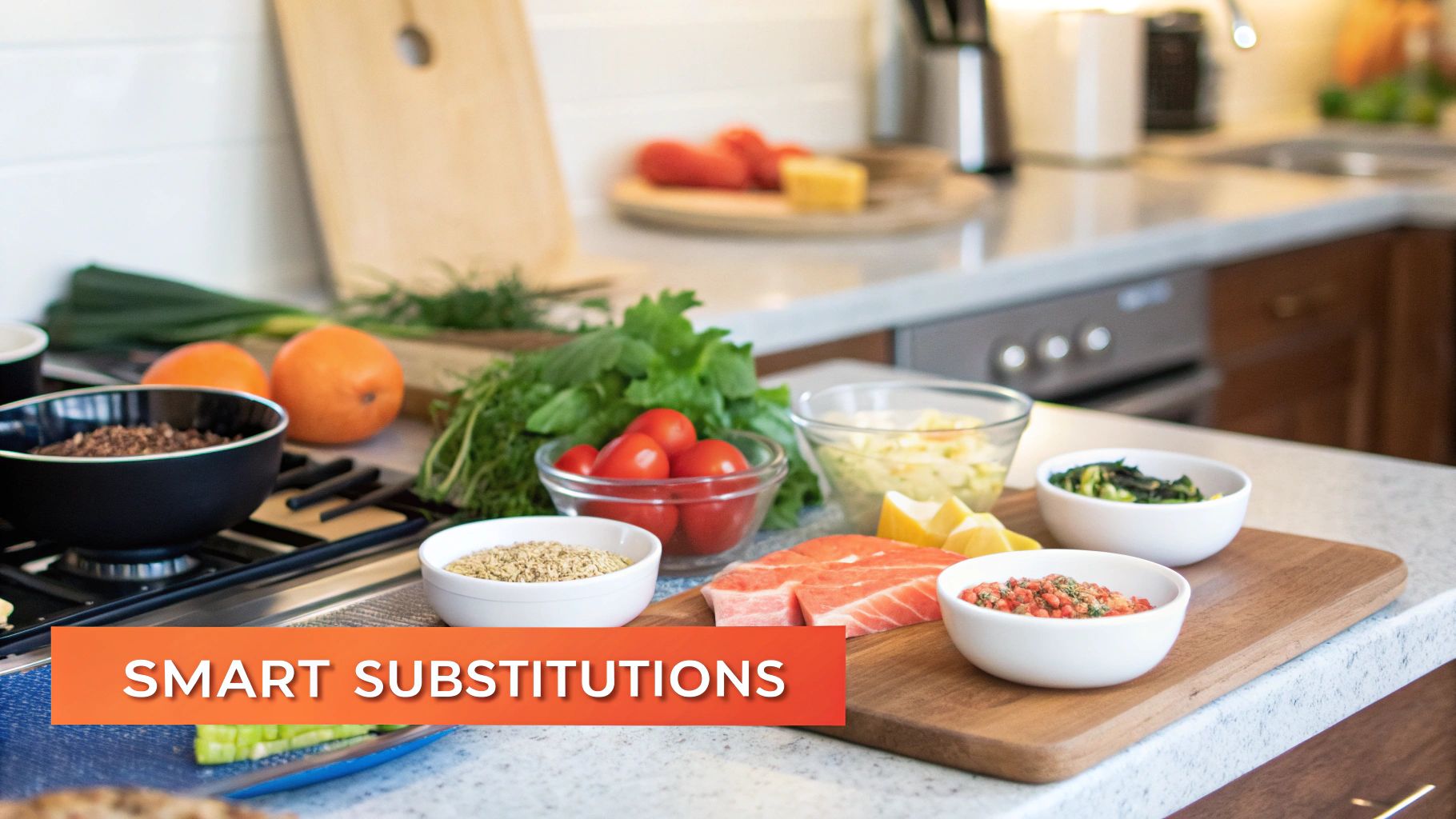
That treasured recipe card from your grandmother might call for a "pinch of salt" or a "butter the size of an egg." These charming, yet vague, measurements can make recreating older recipes a real challenge. This section explores how to decipher these vintage instructions and adapt them for today's kitchen. This way, you can preserve your culinary heritage and enjoy delicious results.
Decoding Vintage Measurements and Ingredients
One of the first hurdles is understanding the vintage measurements. Terms like "a gill of cream" or "a walnut-sized piece of butter" are rarely used now. This shift in measurement practices can make it tricky to accurately replicate the recipe. Vintage kitchen measurements present a unique challenge. Terms like 'a gill of flour' or 'butter the size of a walnut' were commonplace in the past, but less so today. A gill, for example, equals about half a cup.
Understanding these measurements requires some knowledge of historical cooking practices and the use of conversion charts. Explore this topic further. For example, a "knob" of butter is roughly two tablespoons. You'll need to convert this into modern measurements for accuracy. This helps preserve traditional recipes and allows cooks to appreciate how cooking techniques have evolved. Ingredients themselves have also changed. "Sweet milk" refers to whole milk, and "oleo" is an old term for margarine. Knowing these substitutions is vital for capturing the original flavor.
Considering the Evolution of Cooking Equipment
Cooking equipment has changed over time. Grandma's cast iron skillet heats differently than a modern non-stick pan, impacting cooking times and the final dish. Similarly, older ovens often had inconsistent temperatures. This is important to consider when converting recipes with specific baking times. Adjustments might be necessary to achieve the desired outcome.
Methodical Testing and Adjustment
Converting heirloom recipes is like detective work. It involves research, understanding ingredient interactions, and recognizing the limitations of older equipment.
-
Start with research: Look up unfamiliar terms and ingredients to understand the recipe's intent.
-
Test small batches: Convert a smaller portion of the recipe at first to minimize waste and allow for tweaks.
-
Take detailed notes: Record any changes and the results. This information will be valuable for future attempts at the recipe.
Through careful research and testing, you can unlock the secrets of cherished family recipes. Adapt them for your modern kitchen while preserving authentic flavors and culinary traditions. This process allows you to share and enjoy these special dishes for years to come.
The Precise Art of Baking Conversions
Baking, unlike savory cooking, demands precision. Converting baking recipes requires a scientific approach, much like a chemist in a lab. Through conversations with professional pastry chefs and food scientists, it's clear that weight-based measurements are essential for baking success.
Humidity, Altitude, and Flour Power
Humidity and altitude significantly affect flour. Flour absorbs moisture from the air. A cup of flour in Miami will contain more water than a cup in Denver. This seemingly minor difference can drastically change dough hydration and the final product. Altitude also plays a role, affecting atmospheric pressure and how ingredients interact. That's why professionals rely on weight – 100 grams of flour is always 100 grams, regardless of external conditions.
Another factor is protein content, which varies globally. Different flours have different protein levels, impacting gluten development and texture. Italian "00" flour behaves differently than American all-purpose flour, even with identical volume measurements.
Leavening Agents and the Science of Rise
The relationship between leavening agents and flour is crucial. Leavening agents, like baking powder and yeast, create air pockets responsible for rise and texture. Their effectiveness depends on precise ratios, especially with flour. When scaling a recipe, adjust the leavening agent proportionally. Doubling a recipe without adjusting the baking powder could lead to a collapsed cake or a metallic taste.
Adapting Baking Time and Temperature
Converting recipes often means changing pan sizes and oven types, requiring adjustments to baking time and temperature. A larger pan usually needs a lower temperature and longer baking time. Switching from a conventional to a convection oven typically requires reducing the temperature by 25 degrees Fahrenheit and shortening the baking time. Check out this helpful resource: How to master your digital cookbook.
Beyond the Numbers: Visual and Tactile Cues
While precise measurements are essential, sensory cues are invaluable. Experienced bakers rely on sight and touch. A dough that's too sticky or a runny batter might need extra flour or liquid, even if you followed the converted measurements. Trust your instincts and make small adjustments based on your observations. These cues can be more reliable than strictly adhering to converted numbers, particularly when humidity and ingredient variations are involved.
Digital Conversion Tools That Actually Work
Converting recipes by hand can be a real chore. Luckily, several digital tools can simplify this process. From smart scales to AI-powered apps, there are many options to explore. This section looks at genuinely helpful tools and how they can improve your recipe conversion workflow.
Smart Kitchen Scales: Built-In Conversion Power
Smart kitchen scales are a great addition to any modern kitchen. Many models have built-in conversion features, eliminating the need for manual calculations. These scales instantly convert between units like ounces, grams, pounds, and kilograms, making it easy to adapt recipes from different cultures. Some premium scales even consider ingredient density for more precise conversions. This level of accuracy is especially helpful for baking, where measurements need to be spot on.
AI-Powered Conversion: Handling Entire Recipes
AI-powered recipe conversion tools take things a step further. These programs analyze entire recipes, converting all ingredients at once. This saves a lot of time and reduces errors, particularly with complicated recipes. For instance, an AI tool can easily scale a recipe meant for 12 servings down to 4, adjusting all the ingredients accordingly. It's still a good idea to double-check the results, especially with unusual ingredients.
Smartphone Apps: Reliable Results on the Go
Several smartphone apps offer reliable recipe conversion capabilities. Many apps handle standard unit conversions (like cups to milliliters), while others can calculate conversions for specific ingredients. Some even let you save and organize converted recipes, essentially creating a personalized digital cookbook. This is a great way to keep track of recipe adjustments and ensure consistent results. Check out our guide on creating a digital recipe organizer for tips on effective recipe management.
Cloud-Based Recipe Managers: Preserving and Scaling Your Recipes
Cloud-based recipe managers provide a central hub to store and convert your favorite recipes. These services often integrate with other digital tools like smart scales and AI converters. They also usually offer automatic scaling for different serving sizes. For example, you can easily scale a saved recipe from 4 servings to 8 with just a few clicks. This feature is extremely useful for entertaining or meal prepping.
Building Your Own Custom Conversion Database
For ingredients you use often, consider creating a custom conversion database. This can be a simple spreadsheet or a note on your phone. Write down the weight and volume equivalents for your staple ingredients (flour, sugar, spices, etc.). Over time, this personalized database becomes a handy quick reference for accurate conversions tailored to your needs.
Setting Up Your Digital Conversion System
Creating a smooth digital conversion system involves choosing tools that work best for your cooking style and workflow.
-
Consider your needs: Do you often bake and need precise weight conversions? Or do you mostly cook simpler recipes with basic volume adjustments?
-
Explore different tools: Try out different apps and software to see which ones you like.
-
Integrate your tools: Connect your smart scale with your recipe manager for even easier conversions.
By using the right digital tools and strategies, you can streamline recipe conversion, take out the guesswork, and get consistently delicious results.
Ready to simplify your recipe management and conversion? Try Recify, the innovative app that lets you save, organize, and convert recipes from any online source.
